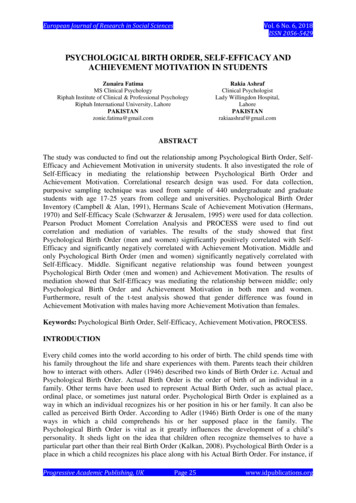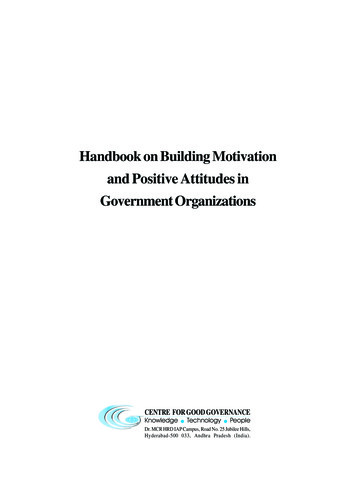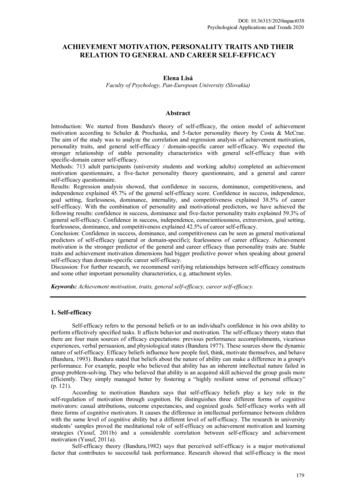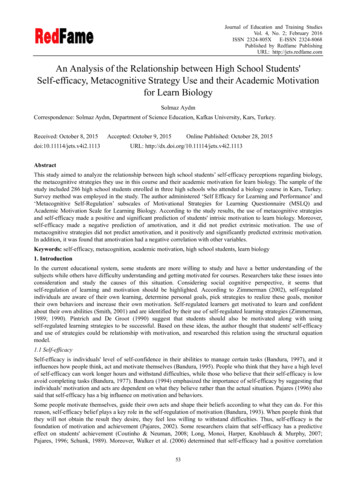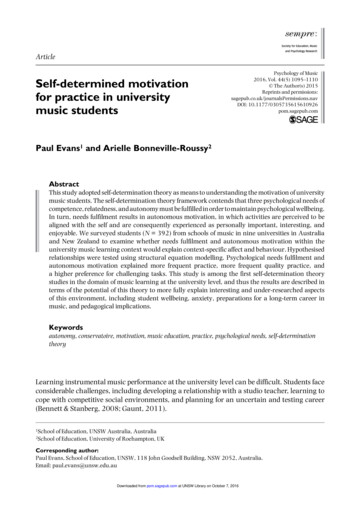
Transcription
10926Psychology of MusicEvans and Bonneville-RoussyArticleSelf-determined motivationfor practice in universitymusic studentsPsychology of Music2016, Vol. 44(5) 1095 –1110 The Author(s) 2015Reprints and OI: 10.1177/0305735615610926pom.sagepub.comPaul Evans1 and Arielle Bonneville-Roussy2AbstractThis study adopted self-determination theory as means to understanding the motivation of universitymusic students. The self-determination theory framework contends that three psychological needs ofcompetence, relatedness, and autonomy must be fulfilled in order to maintain psychological wellbeing.In turn, needs fulfilment results in autonomous motivation, in which activities are perceived to bealigned with the self and are consequently experienced as personally important, interesting, andenjoyable. We surveyed students (N 392) from schools of music in nine universities in Australiaand New Zealand to examine whether needs fulfilment and autonomous motivation within theuniversity music learning context would explain context-specific affect and behaviour. Hypothesisedrelationships were tested using structural equation modelling. Psychological needs fulfilment andautonomous motivation explained more frequent practice, more frequent quality practice, anda higher preference for challenging tasks. This study is among the first self-determination theorystudies in the domain of music learning at the university level, and thus the results are described interms of the potential of this theory to more fully explain interesting and under-researched aspectsof this environment, including student wellbeing, anxiety, preparations for a long-term career inmusic, and pedagogical implications.Keywordsautonomy, conservatoire, motivation, music education, practice, psychological needs, self-determinationtheoryLearning instrumental music performance at the university level can be difficult. Students faceconsiderable challenges, including developing a relationship with a studio teacher, learning tocope with competitive social environments, and planning for an uncertain and testing career(Bennett & Stanberg, 2008; Gaunt, 2011).1School2Schoolof Education, UNSW Australia, Australiaof Education, University of Roehampton, UKCorresponding author:Paul Evans, School of Education, UNSW, 118 John Goodsell Building, NSW 2052, Australia.Email: paul.evans@unsw.edu.auDownloaded from pom.sagepub.com at UNSW Library on October 7, 2016
1096Psychology of Music 44(5)Among these difficulties is sustaining the many hours of practice required to develop performance ability. Practice is a skill that students must hone without much substantial guidance,because in studio lessons, technique and repertoire tend to be prioritised, and little instructional time is devoted to the structure and strategy of practice (Jørgensen, 2009). For the mostdedicated music students, this means that a large proportion of their waking hours is spent onan activity that is relatively unguided and ill-defined (Barry & Hallam, 2002; Jørgensen, 2000;Renwick & McPherson, 2002).As with any other setting, motivation and engagement in learning music at universitydepends on the learning environment. Learning is challenging for university music students iftheir environment is not conducive to effective motivation and engagement. In music at university level, particularly in conservatories and classical performance-based degree programs,research suggests that the studio music environment is often not optimal for student motivation. Studio teaching often adopts a demanding, directive, and controlling style (Creech &Gaunt, 2013; Gaunt, 2011). Even though they may not intend to, teachers can easily dominatelessons by talking and issuing technical demands, with little input from the student (BonnevilleRoussy, Vallerand, & Bouffard, 2013; Burwell, 2015; Young, Burwell, & Pickup, 2003). Thisstyle of teaching can probably be attributed to the master–apprentice relationship that has longbeen a tradition (Jørgensen, 2000), with its roots possibly in the boom of the industrial revolution, where printed method books proliferated, instrument ownership became commonplace,and the music studio teaching industry flourished (Gellrich & Parncutt, 1998).Evidence suggests that this authoritarian approach to teaching may be problematic for students’ motivation to practice. In school settings, a controlling teaching style – one that is directive, where the teacher talks and the student listens, and in which students do not feel anyautonomy – results in less student engagement, less deep learning, and less creativity (Niemiec& Ryan, 2009; Reeve, 2009; Su & Reeve, 2010). This finding is consistent in other domainssuch as parent–child relationships (Grolnick, 2003, 2009), health care (Ng et al., 2012), andwork relationships (Gagné & Deci, 2005). Learning more about whether this finding applies tothe music learning context is therefore important (Evans, 2015).Our aim with the present study was to better understand this issue by studying how university music students are motivated, and how motivation affects three aspects of their practice:(1) how often they practice (practice frequency); (2) how often they practice in a way that theyperceive to be highly productive or rewarding (quality practice frequency), and (3) their preference for choosing challenging tasks above tasks that are easy and within their ability (preference for challenge). Self-determination theory (SDT) formed the theoretical approach to ourunderstanding of students’ motivation. SDT’s central claims are that people’s behaviour,engagement, and wellbeing are products of the quality of their interactions with the socialenvironment (Ryan & Deci, 2000). This study instantiates a broader endeavour to understandthe conditions in the social environment that are needed for students to experience wellbeing,aspire to learn, and fulfil their potential for performance excellence.PracticePractice is one of the crucial learning activities for university music students. Music studentsare often required to do large amounts of practice in order to attain technical and musicalexpertise, become proficient on their instrument, and reach a standard that allows them topursue a career in music performance. The most successful musicians know that deliberatepractice – effortful, strategic, conscious practice – is necessary to produce reliable and consistent improvements in performance (Barry & Hallam, 2002). Yet sustaining large amounts ofDownloaded from pom.sagepub.com at UNSW Library on October 7, 2016
Evans and Bonneville-Roussy1097deliberate practice is inherently difficult, and the motivation required for it is complex (Evans,2015). Much like in other domains, deliberate practice in music is not usually inherently enjoyable in and of itself (Ericsson, Krampe, & Tesch-Römer, 1993). It occurs mostly in social isolation, is cognitively demanding, and requires consistent attention and focus.The deliberate practice framework of Ericsson et al. (1993) has been accepted as the primaryexplanation for expert performance for the last two decades. It is based on the finding of substantially higher accumulations of deliberate practice among expert performers comparedwith non-experts – a finding initially made with university music students. Some debate hasarisen in recent years with the suggestion that deliberate practice may not account for as muchvariance as the deliberate practice approach claims. For example, recent re-analyses of datafrom a number of studies found that deliberate practice accounted for only around 30% of thevariance in performance ability, leaving 70% of the variance explainable by other factors(Hambrick, Altmann, Oswald, Meinz, & Gobet, 2014). Another study found an average correlation between deliberate practice and performance of only around .35 (Macnamara, Hambrick,& Oswald, 2014). Bonneville-Roussy and Bouffard (2015) also found that formal practiceexplained only 18% of the musical achievement of college music students. Ericsson defendedthese challenges (Ericsson, 2014a, 2014b) stating that the deliberate practice framework isrelevant only to expertise, not other types of performance, and that the criteria for includingstudies in the Macnamara et al. meta-analysis were too broad.The debate highlights the need to understand more fully the nature of practice and its relationship with performance ability. Nevertheless, there can be no doubt that deliberate practiceaccounts for a substantial proportion of variance in expert performance and in performancemore generally. Furthermore, there appears to be little doubt that deliberate practice is an absolutely necessary activity for developing expertise in the training of musicians at the universitylevel. In addition, the debate may be further clarified by examining not only the amount ofpractice undertaken (frequency of practice), but also the degree to which practice is in factdeliberate (quality practice). One of the ways that the deliberate practice framework explainsthese factors is through a number of constraints initially identified by Ericsson et al. (1993),including the motivational constraint.Motivation to practiceWhen Ericsson et al. (1993) outlined their deliberate practice framework, they explained thatnot all people can easily accumulate the many hours of practice that appear necessary to attainexpertise. They identified three ‘constraints’ on the attainment of such a large number of hoursof practice. The effort constraint restricts the ability of a person to maintain full attention forsustained amounts of time; the resources constraint limits access to equipment, access to specialist teachers, transportation to lessons, and training facilities; and the motivational constraintis based on the assumption that ‘deliberate practice is not inherently enjoyable, and that individuals are motivated to engage in it by its instrumental value in improving performance’(Ericsson et al., 1993, p. 371). The motivation construct is the focus of the present research.Understanding the circumstances under which practice may be experienced as enjoyableor not, and the extent to which people understand the instrumental value of practice in improving performance, would help universities, teachers, and students to create optimal practiceenvironments (Evans, 2015).Motivation is therefore important to study because it constrains the amount of practice people are able to undertake. But it is also important to study because it influences behavioursother than practice. People’s motivational beliefs – including beliefs about abilities, beliefs aboutDownloaded from pom.sagepub.com at UNSW Library on October 7, 2016
1098Psychology of Music 44(5)whether certain activities are useful in attaining goals, and beliefs about why people do whatthey do – play a substantial role in guiding their behaviours. Motivation also accounts for affective states, psychological wellbeing, the development of personal identity and sense of self, andthe resilience and determination to confront and overcome challenges, all of which are important to musicians. One of the most prominent theories in motivation in recent years – selfdetermination theory – broadly addresses these facets of human life and has been applied todomains such as education, work, sports, personal relationships, and physical and psychological health (Ryan & Deci, 2000). It is a useful framework for understanding motivation for learning music and its relationships with practice and wellbeing (Evans, 2015).Self-determination theorySelf-determination theory (SDT) is an approach to human motivation that describes the socialcircumstances under which people experience wellbeing and vitality. Research in SDT beganwith research on one of the most consistent distinctions in the study of motivation: the concepts of intrinsic and extrinsic motivation (Deci, 1971). These constructs are relatively agreedupon across the motivation literature: intrinsic motivation is doing an activity for its own sakeand because it is enjoyable or interesting, such as playing one’s favourite, learned piece of musicfor pleasure; while extrinsic motivation is doing an activity for any reason other than the activity itself, for example, to get a good grade, to avoid some kind of punishment, or because it isimportant in attaining some other goal. Within SDT, extrinsic motivation is further elaborated,with four different regulatory types, from relatively external to the self to relatively internal andaligned with the self (Ryan & Deci, 2000). For example, relatively external regulations (viz.,extrinsic and introjected regulation) could be a teacher or parent telling you what to do, thepossibility of a good grade, the avoidance of feeling guilty. Relatively internal regulations (viz.,identified and integrated regulation) could be the understanding of how important a task is,realising that a task is instrumental to achieving other personally important goals, or seeingthat the task is an important part of who you are. While these more internalised regulations areconsidered extrinsic motivation, they are aligned with one’s interests and goals, so their behaviours are considered by SDT as being relatively self-determined. The more important distinctionin SDT, therefore, is the alignment of activities with one’s sense of self, rather than whether theactivity is intrinsically or extrinsically motivated. In SDT, relatively internal regulations areconsidered to be more autonomous forms of motivation than relatively external regulations(for a more thorough review, see Evans, 2015).Autonomous motivation is fuelled by the fulfilment of basic psychological needs. Accordingto SDT, there are three basic psychological needs which, when fulfilled, provide nutriments forgrowth, vitality, and wellbeing (Deci & Ryan, 2000). The needs comprise the need to feel effective and able in one’s efforts and in interacting with the social environment (competence), theneed to feel accepted and connected by others in social networks (relatedness), and the need tofeel as though one’s actions are aligned with one’s sense of self (autonomy). When people’spsychological needs are fulfilled within a domain, they experience the domain as more enjoyable, they engage in activities with meaning and purpose, and they experience wellbeing indomain-related contexts.In domains related to music learning, the SDT framework is supported by a wealth of evidence. In education, for example, studies have found that when teachers are autonomy supportive and provide structure, their students are more engaged (Jang, Reeve, & Deci, 2010), andwhen they are more controlling, their students suffer (Soenens, Sierens, Vansteenkiste, Dochy,& Goossens, 2012). Another consistent finding is that intrinsic motivation is associated withDownloaded from pom.sagepub.com at UNSW Library on October 7, 2016
Evans and Bonneville-Roussy1099academic achievement (for a recent review and meta-analysis, see Taylor et al., 2014). Incountless applied domains, SDT research shows that psychological needs fulfilment and internalised forms of motivation explain more autonomous, healthy forms of functioning andaccount for substantial variance in outcomes such as creativity, deep learning, wellbeing, passion, and growth.Researchers have begun to explore SDT’s applications in music education. In one study, psychological needs in children and adolescents were more fulfilled when they were highly engagedin their music learning than at the time they ceased music learning activities (Evans, McPherson,& Davidson, 2012). One of these children was observed in a qualitative study to use moresophisticated practice strategies in her practice when she had autonomously self-selected herrepertoire (Renwick & McPherson, 2002). In another study, different types of motivation regulation in children were associated with practice behaviours – effort management, monitoring,and strategy use – and motivated students to prepare for performance examinations in differentways (Renwick & Reeve, 2012). In university students, Bonneville-Roussy et al. (2013) showedthat autonomy support from music teachers led to more harmonious passion and ultimately togreater persistence in music education whereas controlling behaviours from teachers were notlinked to persistence. (For a conceptual overview of SDT in music education, see Evans, 2015.)No study, to our knowledge, has yet examined university students’ practice quantity or practicequality using self-determination theory.The present studyThe aim of the present study was to test, within a SDT theoretical framework, how the perception of needs satisfaction from the music learning environment can shape university musicstudents’ motivation towards music, and, in turn, the frequency and quality of their practice.Past research has shown that satisfaction of the needs for autonomy, competence, and relatedness promotes more self-determined forms of motivation (Deci & Ryan, 2000; Hagger,Chatzisarantis, & Harris, 2006). Therefore, we hypothesized that music students who perceivedthat their psychological needs were satisfied by their musical environment would have moreautonomous motivation towards music.In addition, past research in other educational areas has found that autonomous motivation is linked to better engagement, persistence, and overall academic success (Deci, Vallerand,Pelletier, & Ryan, 1991; Niemiec & Ryan, 2009). In the present study, three aspects of practice behaviour were examined: practice frequency (how often the students practised), qualitypractice frequency (i.e. how often practice was productive or rewarding), and preference forchallenge (the degree to which students preferred to set themselves challenges that exceededtheir ability but were within reach, as compared with choosing tasks that were comfortableand well within their ability). In line with past research, we hypothesized that more autonomous motivation would lead to higher practice frequency, higher quality practice frequency,and higher preference for challenge. We tested these hypotheses using structural equationmodelling.MethodParticipantsParticipants were 410 university music students from nine schools of music at universities inAustralia and New Zealand. Students were enrolled in undergraduate music degree programsDownloaded from pom.sagepub.com at UNSW Library on October 7, 2016
1100Psychology of Music 44(5)in which music performance is a core requirement, and in which students receive regular studio tuition. There were 146 (36%) males, 256 (63%) females, and 3 selected ‘other’ or chosenot to respond. The mean age was 21.61 years (SD 5.49). The participants completed theconsent process and the survey online. Administrators in each of the nine universities wereasked to forward a link to the online survey to all students in undergraduate music programsthat had performance as a substantial component. Ethics approval was obtained for the studyfrom the UNSW Human Research Ethics Advisory Panel.MeasuresPsychological needs satisfaction. Competence, relatedness, and autonomy were measured basedon the Balanced Measure of Psychological Needs (BMPN; Sheldon & Hilpert, 2012). In thisscale, the needs are measured using three positively-worded and three negatively-worded itemseach, resulting in 18 items (only the positively-worded items were used in the present study toexamine psychological needs satisfaction). Participants responded to each item on a 7-pointscale from ‘not at all true’ to ‘very true’. To measure the needs in the intended context, the stem‘In my music learning and playing, ’ was stated before the set of 18 items. The BMPN is adomain-general measure of psychological needs, so minor changes to some item wordingswere made so that the items were appropriate to the context (e.g. ‘I successfully learn difficultthings’ was adapted to ‘I successfully learn difficult music’). We refer to this adapted instrumentas BMPN–Music throughout this paper.Autonomous motivation. Measures were adapted from Ryan and Connell’s (1989) widely-usedmeasures of these types of motivation in academic settings, the self-regulation questionnaire(SRQ); we refer to our minor adaptation as SRQ–Music throughout this paper. Two blocks ofitems were presented, with the stems ‘Why do you play and learn music?’ and ‘Why do youhave music lessons?’, respectively. In each block, four types of motivation regulation weremeasured, ranging from relatively external to relatively internal regulation, by two itemseach: extrinsic regulation (e.g. ‘because I am supposed to’), introjected regulation (e.g. ‘soI can show off my abilities’), identified regulation (e.g. ‘because I wanted to be a good musician’),and intrinsic motivation (e.g. ‘because I love playing my instrument’). These items wereparcelled and used as indicators of a single latent variable named ‘autonomous motivation’(see Results section).Practice frequency. Participants were asked ‘How many times have you practised on your instrument in the last 7 days (do not include lessons)?’ to measure the frequency of their practice.Quality practice frequency. We assessed practice quality using a single item, “How many of yourpractice sessions in the last 7 days were really productive or rewarding?”Preference for challenge. We asked participants to respond to the item, ‘Next time I select a newpiece of music to play, it will be ’ on a 7-point scale from ‘well within my ability’ to ‘challenging and above my ability’.Affect. We asked participants how much they felt affective states in their music learning andplaying – happy, relaxed, excited, proud, unhappy, nervous, guilty, and angry – in response tothe question, ‘In my music learning and playing, I feel ’.Downloaded from pom.sagepub.com at UNSW Library on October 7, 2016
Evans and Bonneville-Roussy1101ResultsAnalytical approachWe addressed the aims of this project within the analytical framework of structural equationmodelling (SEM). SEM is a statistical method that aims at measuring the relationship betweena set of variables and assessing causal relationships between constructs. It uses model fit indicesto evaluate whether the modelled relationships between variables are a meaningful representation of the data. Confirmatory factor analysis (CFA) in the SEM framework has several advantages compared with traditional exploratory factor analysis (Brown, 2006; Muthén & Muthén,2010). First, model fit indices allow researchers to assess whether the number of factorsretained in a given analysis provides appropriate fit to the data. Second, it provides a standarderror of means for the observed variables. This allows researchers to test the significance of anobserved variable on a latent construct. Measurement models in SEM also provide error variances of observed variables that indicate the amount of unexplained variance. Finally, CFAtests for more stringent, theory-driven measurement models, as the observed variables arehypothesized to be represented by only one factor.In our analyses, model goodness-of-fit was evaluated according to the recommendations ofMarsh et al. (2009). That is, a model was deemed to have acceptable fit with a comparative fitindex (CFI) equal to or higher than .90 (and an excellent fit equal to or greater than .95) and aroot mean square error of approximation (RMSEA) and standardized root mean square residuals (SRMR) equal to or less than .08 (or less than .05 for an excellent fit). The issue of chi-squarehas been debated. Traditionally, it has been argued that non-significance of chi-square shouldbe met; however, as chi-square indices are inflated by sample sizes and model complexity (number of degrees of freedom), they are more likely to be significant when larger sample sizes areused and when the model has a high degree of complexity (Brown, 2006; Kline, 2010).Therefore, in this work, chi-square statistics are interpreted with caution.In the approach to the present study, we took advantage of SEM in several ways. First, weperformed two CFAs to confirm the validity of our psychological needs satisfaction and autonomous motivation scales. Based on the results of these CFAs, we then computed variables forneeds satisfaction and relative autonomy index (RAI) parcels for use in subsequent analyses.We used a full structural equation model to address our main research objectives. Finally, wepresent computed factor scores and their correlations with affect variables to more fully understand the relationships between motivation, practice, and affect. All of the analyses were performed using Mplus version 7.3 (Muthén & Muthén, 2014).Psychological needs satisfaction scale (BMPN–Music)We used a CFA to examine the validity of the three needs satisfaction dimensions (autonomy,competence, and relatedness). Since the BMPN–Music measures the three psychological needsusing positively and negatively worded items, we conducted a second-order CFA to assess, first,the validity of the positive and negative valence of each sub-scale (e.g. autonomy positivelyworded and autonomy negatively worded, for a total of six subscales). Then we assessed whetherthese positive and negative subscales (e.g. autonomy satisfaction, autonomy thwarting) formedsingle latent constructs (e.g. autonomy) in a second higher-order factor analysis. Results confirmed that the second-order factor analysis fit the data well, χ2125 233.42, p .001, CFI .96,TLI .95, RMSEA .05 (95% CI .04–.06), SRMR .06. Standardised loadings on the factorsranged from .51 to .83 for the lower-order subscales and varied from -.46 (negative subscale) toDownloaded from pom.sagepub.com at UNSW Library on October 7, 2016
1102Psychology of Music 44(5)1.00 (positive subscale) for the higher-order dimensions, with all loadings significant at p .001(specific loading values are available from the corresponding author). These results confirm thevalidity of the BMPN–Music scale.Given our sample size limitations, and the requirement for model parsimony, we created itemparcels for the psychological needs by summing the individual positively-worded items withineach need. The higher-order CFA above justified this approach of using composite scores forcompetence, relatedness, and autonomy.Autonomous motivation scale (SRQ–Music)To examine the factor structure of the autonomous motivation scale, we performed a CFA withthe 16 SRQ–Music observed variables. These variables have been shown in past research torepresent four types of motivation regulation, with four items representing each form of regulation, from relatively internal to relatively external: intrinsic, identified, introjected, and external (Ryan & Connell, 1989). Results of the CFA confirmed the four-factor structure of the scale,χ294 226.91, p .001, CFI .94, TLI .93, RMSEA .06 (95% CI .05–.07), SRMR .06.Standardized loadings on the factors ranged from .39 to .88 and all were significant at p .001(specific loadings are available from the corresponding author). These results show that thefour types of motivation are well represented by their corresponding items.In the subsequent structural model, we required a single measure of autonomous motivationto maximise statistical power and to best take advantage of the sample size. To use the SRQ–Mitems as a single measure of motivation internalisation, we adopted the approach used in previous research (e.g. Niemiec et al., 2006; Ryan & Connell, 1989) of creating a relative autonomyindex (RAI). In the RAI, more weight is put on intrinsic and extrinsic forms of regulation. Ahigher positive score indicates a more autonomous motivation. Ryan and Connell (1989) firstdeveloped the RAI by using weighted measures of each type of regulation, such that:RAI 2 Intrinsic Identified - Introjected - 2 ExtrinsicWe employed this procedure to create item parcels: four parcelled RAI indicator variableswere computed based on the equation above, selecting one item randomly from each of the fourtypes of extrinsic motivation in the SRQ–Music. In the subsequent structural model, the itemparcels were used as indicators of a latent variable, which we named autonomous motivation.Descriptive statisticsTo detect and remove multivariate outliers, we computed the Mahalanobis distance using allvariables in the path analysis model below. Mahalanobis distances were standardised, and atotal of 8 cases with scores greater than 3 standard deviations from the mean were removed.Descriptive statistics and correlations for all observed variables are presented in Table 1.Small to moderate correlations were observed, as expected, between practice variables andalmost all of the motivation variables used in the following models.Full SEM of needs satisfaction, autonomous motivation, and musical practiceTable 2 presents the descriptive statistics and correlation coefficients of the variables includedin our main hypothesized model. Because our three measures of practice were skewed, we usedDownloaded from pom.sagepub.com at UNSW Library on October 7, 2016
1103Evans and Bonneville-RoussyTable 1. Descriptive statistics and correlation coefficients of the observed and parcelled variablesincluded in this study.VariablesMeanSD1234567891. Practice frequency2. Quality practice frequency3. Preference for challenge4. Competence5. Relatedness6. Autonomy7. RAI18. RAI29. RAI310. 26*.32*–.62* –.50* .48* –.42* .47* .49*Note: N 392; RAI Relative Autonomy Index.*p .01.Table 2. Descriptive statistics and correlation coefficients of the variables of the structural model of selfdetermined motiv
Paul Evans, School of Education, UNSW, 118 John Goodsell Building, NSW 2052, Australia. Email: paul.evans@unsw.edu.au 610926 POM 010.1177/0305735615610926Psychology of MusicEvans and Bonneville-Roussy research-article 2015 Article Downloaded from pom.sagepub.com at UNSW Library on October 7, 2016

